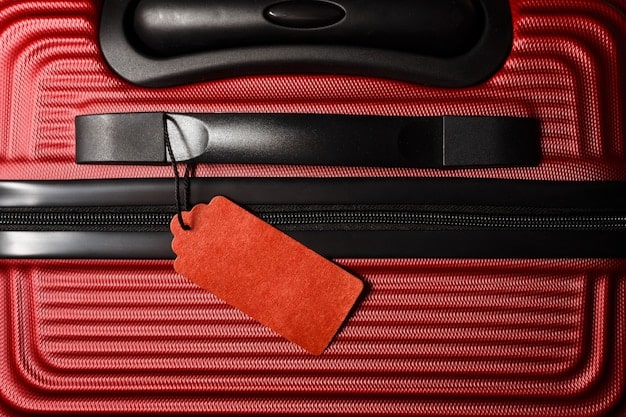Lost Luggage Survival Guide: Your 2025 Edition for Missing Bags

Lost luggage can disrupt any trip; this 2025 survival guide offers actionable strategies, from pre-flight preparations to post-arrival procedures, ensuring travelers are equipped to handle baggage mishaps effectively and minimize travel disruptions.
Losing your luggage can be a major travel headache. But don’t panic! This Lost Luggage Survival Guide: What to Do When Your Bags Go Missing (2025 Edition) provides a comprehensive plan to navigate this stressful situation and get your belongings back, or at least minimize the disruption to your trip.
Lost Luggage: Prevention is Key
Preventing luggage loss is always better than dealing with the aftermath. Taking proactive steps before you even leave for the airport can significantly reduce the chances of your bags going missing.
Use Smart Luggage Tags
Traditional luggage tags can easily be torn off. Smart luggage tags offer a more secure and tech-savvy solution.
- Trackers: Attach a Bluetooth or GPS tracker like an Apple AirTag or Tile to your luggage. This allows you to monitor its location via your smartphone.
- Digital Tags: Consider digital tags with QR codes. These tags can display your contact information when scanned but protect your privacy by not showing it outright.
- Durable Materials: Choose luggage tags made from sturdy materials like metal or reinforced plastic that can withstand rough handling.
Clear External and Internal Identification
Make sure your contact information is clearly visible both inside and outside your bag.

By taking proactive measures to protect your luggage, you can significantly reduce the risk of loss and enjoy a smoother travel experience. However, even with the best precautions, luggage can sometimes go missing.
Report Lost Luggage Immediately
If your luggage doesn’t arrive at your destination, act fast. The sooner you report the loss, the better your chances of recovery.
File a Claim at the Airport
Head straight to the baggage claim office of the airline you flew with. Look for signs or ask airport staff for directions.
- Provide Details: Be prepared to provide a detailed description of your luggage, including its color, size, brand, and any distinguishing features.
- Baggage Tag: Present your baggage claim tag. This tag is crucial for the airline to track your bag.
- File a PIR: The airline will give you a Property Irregularity Report (PIR). This document is essential for tracking your claim and seeking compensation.
Follow Up Regularly
Don’t rely solely on the airline to find your luggage. Take an active role in the search.
Reporting lost luggage promptly and following up diligently can significantly improve your chances of a successful recovery. Be persistent, document everything, and don’t hesitate to escalate your claim if necessary.
Understand Your Airline’s Lost Luggage Policy
Airlines have specific policies regarding lost luggage, including timeframes for recovery and compensation. Familiarize yourself with these policies to understand your rights and what to expect.
Timeframe for Recovery
Airlines typically have a timeframe within which they attempt to locate and return your luggage. This period can vary, but it’s often around 21 days.
- Delayed vs. Lost: Understand the difference between delayed and lost luggage. Delayed luggage is temporarily misplaced, while lost luggage is considered permanently missing after a certain period.
- Tracking Updates: Ask the airline how you will receive updates on the search for your luggage. Some airlines provide online tracking tools, while others communicate via phone or email.
- Escalation: If you don’t receive updates or your luggage isn’t found within a reasonable timeframe, ask to speak to a supervisor or file a formal complaint.
Compensation for Lost Luggage
Airlines are liable for lost, delayed, or damaged luggage, but there are limits to the compensation they offer.
Understanding your airline’s lost luggage policy is crucial for navigating the claims process and receiving appropriate compensation. Document everything, be persistent, and know your rights as a passenger.
Essential Steps After Reporting Lost Luggage
Once you’ve reported your lost luggage, there are several important steps to take to mitigate the impact on your trip and ensure a smoother claims process.
Document Everything
Meticulous record-keeping is essential for a successful claim.

Emergency Essentials
If your luggage contains essential items, like medication or toiletries, purchase replacements and keep the receipts.
Taking these steps after reporting lost luggage will help you stay organized, minimize disruptions to your trip, and build a strong case for compensation. Remember to document everything and communicate regularly with the airline.
Navigating Insurance Claims for Lost Luggage
Travel insurance can provide additional coverage for lost luggage beyond what the airline offers. Understanding your policy and filing a claim correctly is essential.
Check Your Policy
Carefully review your travel insurance policy to understand the coverage for lost, delayed, or damaged luggage.
- Coverage Limits: Be aware of the maximum amount the policy will pay out for lost luggage.
- Exclusions: Note any exclusions, such as high-value items or specific circumstances not covered by the policy.
- Deductibles: Understand any deductibles you may need to pay before the insurance coverage kicks in.
File Your Claim
Contact your insurance provider as soon as possible after reporting the loss to the airline.
Navigating insurance claims for lost luggage can seem daunting, but understanding your policy, documenting your loss, and following the claims process carefully can increase your chances of receiving fair compensation. Don’t hesitate to seek assistance from your insurance provider if you have any questions or concerns.
Staying Positive and Prepared for Future Travel
Losing luggage is undeniably frustrating, but maintaining a positive outlook and learning from the experience can help you navigate the situation more effectively and prepare for future travel.
Embrace Flexibility
Accept that travel plans can change unexpectedly.
By staying positive, learning from your experiences, and taking proactive steps to protect your belongings, you can minimize the risk of future luggage mishaps and enjoy a smoother, more stress-free travel experience. Even with the best preparations, things may go wrong. Stay calm, adaptable, and focus on making the most of your trip.
| Key Point | Brief Description |
|---|---|
| 🏷️ Smart Tags | Use trackers or digital tags to monitor your luggage. |
| ✈️ Report Fast | File a claim at the airport baggage office immediately. |
| 📜 Airline Policy | Understand airline’s timeframe and compensation policies. |
| 🛡️ Insurance | Check your travel insurance for lost luggage coverage. |
FAQ: Lost Luggage Survival Guide
▼
File a report immediately at the airline’s baggage claim office. Provide your baggage tag and a detailed description of your bag. Obtain a Property Irregularity Report (PIR) for tracking purposes.
▼
Airlines typically search for around 21 days. Keep in contact with the airline to follow the progress.
▼
Compensation varies by airline. Always check what is covered. Keep track of all expenses incurred.
▼
Yes, buy essentials like toiletries and medication. Keep the receipts. Submit receipts when asking for reimbursement.
▼
Use smart luggage tags. Be sure your identification is visible. Choose durable luggage and remove old tags.
Conclusion
Losing your luggage is a frustrating experience, but by following this **Lost Luggage Survival Guide**, you’ll be well-equipped to handle the situation effectively. Remember to act quickly, document everything, understand your rights, and stay positive. Safe travels!





